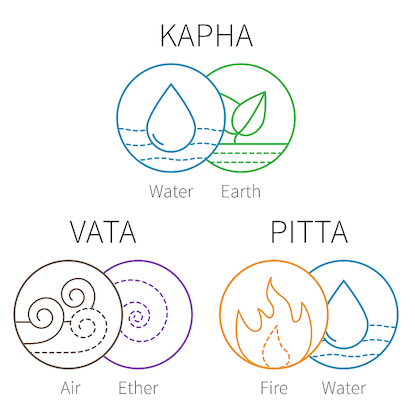When it comes to our wellness, too often people evaluate and treat symptoms as a means of measuring overall health. The problem with this approach is that it so often ignores the underlying or root causes of the true issue. Ayurveda is an approach to health and wellness that takes every facet of a person into consideration. For this reason, I was drawn to learn more about it. So let’s start with learning about the basics of Ayurveda.
First and foremost, what is Ayurveda?
The name “Ayurveda” comes from two Sanskrit words: ayuh meaning “life” or “longevity” and veda meaning “science” or “knowledge.” Thus, Ayurveda is “the science of longevity” or “the knowledge of life.”

Ayurveda represents a holistic approach to healing. It seeks to understand deeper causes of health conditions to discover the primary cause of an ailment. This includes evaluating diet, lifestyle, genetics, emotions and energetic imbalance. The primary focus of Ayurvedic practice is abiding by a healthy lifestyle and conscious prevention of illness. This is because it is always preferable to avoid an illness or treat it in its early stages, rather than allowing it to develop.
An Ayurvedic approach examines a person as an interconnected complex of body, vital energy, mind and soul. Rather than focusing on symptoms, it seeks to evaluate imbalances of these forces, which precede every dis-ease. A symptom provides a warning of an imbalance and indicates a need for a deeper level of correction. In this way, the goal in Ayurveda is to restore a natural state of harmony in the body. When this harmony is achieved, it manifests as mental and physical health.
The Basic Principles of Ayurveda
According to Ayurveda, every individual is made up of five primary elements: ether (space), air, fire, water and earth. Just as seen in nature, we possess these five elements within us. When these elements become imbalanced in the environment, they will in turn have an influence on us. Factors such as the foods we eat and the weather influences these elements to create or disrupt balance.

Doshas
In Ayurveda, three doshas exist to describe a person’s mental and physical characteristics: pitta, vata, and kapha. Each person has a unique ratio of each of these three doshas (prakriti), which is determined at conception. All three doshas exist in everyone, but the ratio among them varies from one person to the next. Each dosha thrives under a specific diet, lifestyle, and exercise regimen. An imbalance can lead to illness and dis-ease.
Before we get too far into that, here is a brief overview of the essential nature of each dosha.
Vata Dosha
Energy: Vata derives from the elements of ether and air. It is the energy of movement. The balanced Vata individual is active, creative, and outgoing with a natural ability to express and communicate. Common signs of Vata imbalance include anxiety and disorders related to dryness, such as dry skin and constipation.
Vata Qualities: dry, rough, light, cold, subtle, and mobile
Characteristics: Physiologically, Vata governs bodily processes related to movement, such as breathing, talking, nerve impulses, muscle movements, circulation, assimilation of food, elimination, urination, and menstruation. Psychologically, Vata governs communication, creativity, flexibility, and joy.
Pitta Dosha
Energy: Pitta derives from the elements of fire and water. It is the energy of digestion and metabolism in the body. The balanced Pitta individual exhibits a joyful disposition, as well as a sharp intellect, courage and drive. When imbalanced, anger, rage, and bitterness can result. Common physical manifestations of an imbalance include burning infection, heartburn, inflammation, rashes and fever.
Pitta Qualities: oily, sharp, hot, light, moving, liquid, and acidic
Characteristics: Physiologically, Pitta provides the body with heat and energy through metabolism. It also governs processes related to transformation throughout the mind and body. Psychologically, Pitta governs courage, willpower, anger, jealousy, and ambition.
Kapha Dosha
Energy: Kapha derives from the elements of earth and water. When balanced, Kapha-dominant individuals are calm, compassionate, and patient. An imbalance may cause withdrawal, depression, and low energy, as well as obesity, inflammation, or congestion.
Kapha Qualities: moist, cold, heavy, dull, soft, sticky, slow and static
Characteristics: Physiologically, Kapha lubricates joints, stores energy, and relates to fluid balance and growth. Psychologically, Kapha governs love, patience, forgiveness, greed, attachment, and memory.

Understanding Your Constitution
Your Ayurvedic body type, or prakriti, is established at conception and remains constant throughout your lifetime. It represents your natural state of equilibrium and homeostasis. Your constitution governs your physiology, likes and dislikes, tendencies and habits, character, and your vulnerabilities toward imbalance and disease.
Health is the optimal state of harmonious body functioning. It represents a balance among vata, pitta, and kapha according to a person’s prakriti. So you see, the Ayurvedic approach to healing is to restore the balance within each individual.
Approach to Ayurvedic Healing
Ayurveda places an emphasis on prevention and seeks to treat the cause of an illness, as opposed to the symptom(s). It focuses on getting to the root of the problem, supporting the immune system, and minimizing stress that often leads to imbalances and illness.
Among the basics of Ayurveda are diet and exercise. For example, balance is often accomplished through diet and food combinations specific to each prakriti. Additionally, the incorporation of yoga can produce a cooling or heating effect on the body. Learning yoga from an Ayurvedic perspective can help you determine which poses would bring optimal wellness.
Ready to Determine Your Dosha?
Take this simple quiz to find out your dosha and begin incorporating the basics of Ayurveda in your lifestyle!












